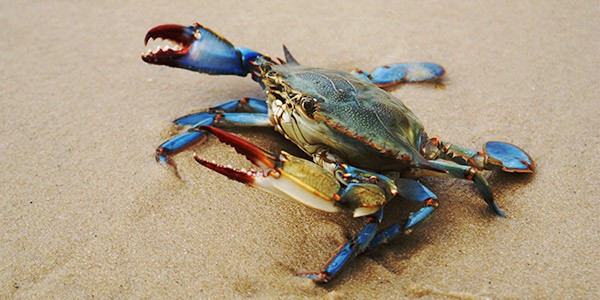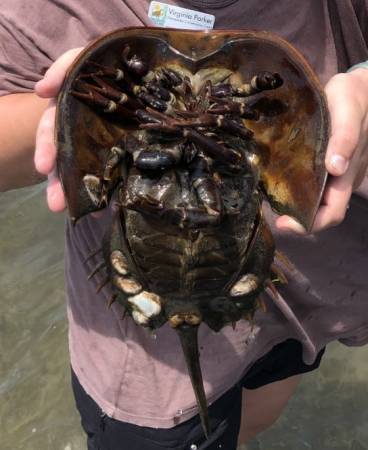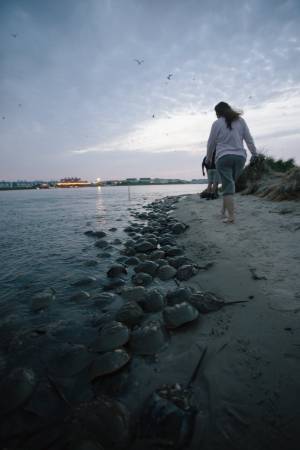Have you ever found yourself wondering where all your favorite Coastal Bays creatures go during the long winter months? Well, fret no longer! Below you will find the winter whereabouts of some of the Maryland Coastal Bays Program’s favorite creatures!
Atlantic Blue Crab (Callinectes sapidus)
The blue crab is one of the most distinctive crustaceans of this region, with its bright blue claws and paddle-like fifth legs, they are famously strong swimmers. While often considered to be a rather tough creature, these hard-shelled animals do not have much tolerance for cold water temperatures. So during the winter months, they retreat into deeper waters and burrow into sediment to wait out the cold. You might be tempted to call this practice hibernation, however, crabs do NOT hibernate, they simply lie dormant through the winter months.

When water temperatures get below 50 degrees, typically sometime in November, blue crabs will leave shallow waters and burrow into the muddy or sandy bottom of deeper waters. They do this by forcing their abdomen backwards and, using their hind legs, dig into the sediment. To view this burrowing in action, click here! Once they are burrowed safely, they will remain entirely emerged and in this dormant state until waters warm in May, when mating season begins. From May to October, these are very economically popular critters and can be found throughout the Coastal Bays.
Horseshoe Crabs (Limulus polyphemus)

In the late spring and early summer months, these ancient relatives of spiders and scorpions can be found spawning in huge masses along our bayside beaches. But, where do these creatures spend the winter months? Well, after spawning, the eggs will hatch within the next few weeks. Then, throughout the next month, the juveniles (which simply look like miniature adult horseshoe crabs without telsons) will enter the water during a high tide event and spend the first few years of their life on the sandy bottom of tidal flats. As they age, they will slowly move further and further from shore. Adult horseshoe crabs slowly begin to feed (favorite foods include worms, clams, and the

occasional algae) at deeper and deeper water depths, meaning that they will spend the winter in deep bay waters and in offshore areas looking for food. Horseshoe crabs have been documented going anywhere from 10 – 100 fathoms (60 – 600 feet) to eat in the winter months. Then when waters begin to warm, they will turn around and head back up to the shoreline to begin spawning again! If you would like to become more familiar with these amazing creatures and see these mass spawning events up close and personal, volunteer with MCBP’s annual horseshoe crab survey!
Osprey (Pandion haliaetus)
Next, we have one of the most famous birds of prey, the osprey. Osprey are a North American raptor famous for their immaculate diving abilities and live fish diet. From spring to fall, in the Coastal Bays watershed, ospreys are frequently spotted over any open water source with an abundant fish supply. Female ospreys will lay eggs (typically 3) around April or May and then incubate them for about a month. These young will remain with their parents for about two months after they fledge, and then make their first migration to their wintering grounds on their own. Once at their wintering

location, they will remain there for a few years before returning north to find a mate.
Now you may be asking yourself…where are these elusive wintering grounds? Well, most ospreys that breed in North America migrate to Central and South America for the winter (check out this Osprey range map). Some are known to overwinter in Florida and many choose the warmth of Mexico. All osprey return to the same wintering grounds every year, instinctively knowing where to return. And don’t worry, if you have grown accustomed to seeing your beloved raptor friend fishing every day, they return to the same breeding ground every year too!
While many creatures leave the coastal bays until the spring and summer, there are plenty that make winter migrations to our area! To learn more about some of the winter wildlife in our area, click here and to learn specifically about the waterfowl that call our watershed home in the winter, click here!
________________________________________________________________________
Chandler Joiner is an Environmental Educator with the Maryland Coastal Bays Program. She is responsible for developing and leading a variety of environmental education programs, including student field trips, in-class lessons, summer camps, adult learning opportunities, and more. Chandler is also responsible for the creation and implementation of MCBP’s Living Local project, which includes community farm visits, educator trainings, and student farm field trips. Click here to learn more about the Living Local project, and if you are interested in learning more about MCBP’s educational programming, please email cjoiner@mdcoastalbays.org.

